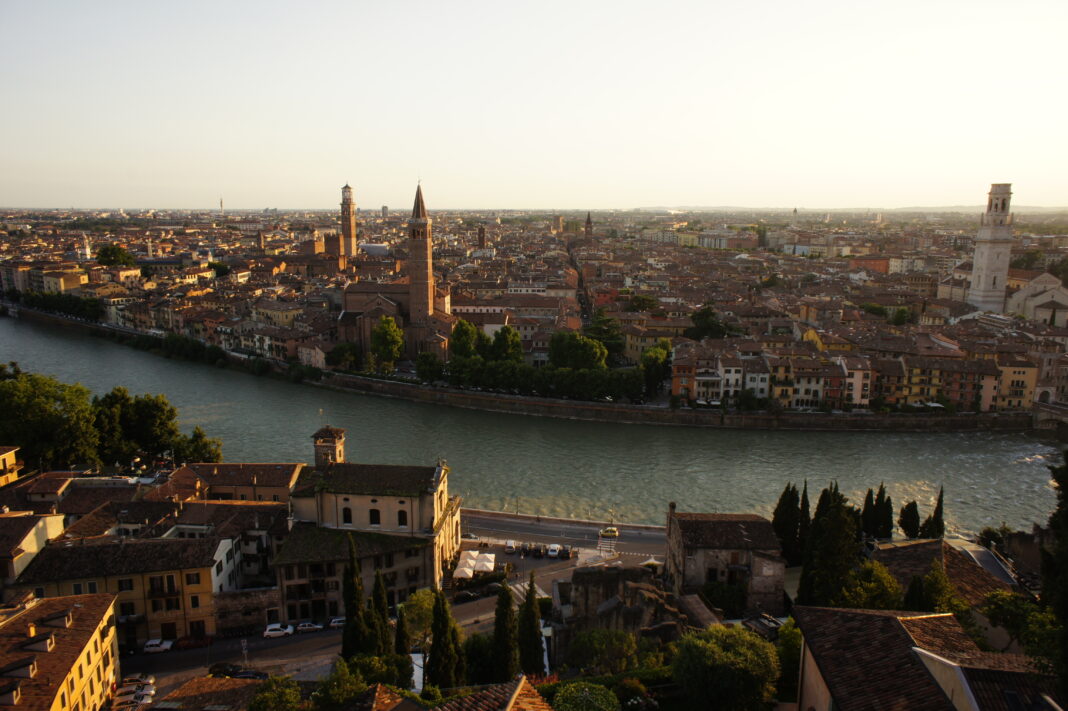Think you’ve never heard of Verona? We know for a fact that’s not true. The northern Italian city is the setting of one famous Shakespeare play and one very famous Shakespeare play: The Two Gentlemen of Verona and Romeo and Juliet, respectively. Though the latter doesn’t have the happiest of endings, it does bring pre-Renaissance Verona to life. You can almost hear the wingbeat of martins as they dart across the Adige River and soar past the medieval Old Town’s bell towers and jasmine vines.
Verona isn’t the home of feuds and duels and double suicides anymore. Rather, it’s a sleepier version of its former grand self, perfect for a low-key detour when travelling between Venice and Milan. Its metro population of about 714,000 is also quietly queer-friendly. (Verona Pride usually happens in June.) That said, we wouldn’t be recommending it if it were just a party destination. The entire 2,000-year-old city is a UNESCO World Heritage Site stocked with Roman remains and literary pilgrimage sites. It might be worth grabbing some wine and risotto at the nearest osteria and planning your itinerary through this meandering city.
City of lovers (of all stripes)
Verona has many nicknames, but it often gets dubbed the Striped City for its many pink-and-white limestone buildings. The nickname that really draws crowds, however, is “City of Lovers,” which draws from the city’s connection to Romeo and Juliet. This isn’t just a gimmick, though. Romeo Montague and Juliet Capulet are based on real families—the Montecchi and Capuleti—who lived in Verona in the 13th and 14th centuries. These days, you can visit the house that’s said to have inspired Shakespeare (Casa Di Casa Di Giulietta, Via Cappello 23, Verona) and rub the breasts of Juliet’s statue for good luck. If you get tired of watching horny middle-aged men fondle Juliet, you can pay 12 euros to step inside her home and take pictures on her famous balcony.
But soft! That’s not the only famous Romeo and Juliet locale. You can also visit the Basilica San Zeno Maggiore (Piazza San Zeno 2, Verona), the Romanesque church where the real-life Romeo and Juliet supposedly got married. Admire the church’s ship hull–shaped ceiling before marching off to La Tomba di Giulietta (Via Luigi da Porto 5, Verona), a gloomy crypt where Juliet and Romeo met their maker.
You might want to get drunk after all that depressing teen romantic drama. Well, you’re in luck. Thanks to the work of local queer rights organizations, the city has a thriving, if small, queer population. You can find some of the local queens at the LGBTQ+-oriented Luclà Cafè (Via Marcantonio Bentegodi 4/A, Verona), where affordable drinks mix with a cozy space to create easy camaraderie, especially on weekends. The Veronese will surely make you feel at ease—this city is the former home of Dante, after all, so sinners roam freely. When you’re done for the night and you want to stay on theme, you can crash at the elegantly understated Hotel Giulietta E Romeo (Vicolo Tre Marchetti 3, Verona).
When in Little Rome
Another Veronese nickname is “Little Rome,” which stems from Verona’s abundant Roman wonders. You’ll encounter, even accidentally, at least one ancient Roman gate or wall—they are truly everywhere. Still, the real draw is the 2,000-year-old Arena di Verona (P.za Brà 1, Verona), which is the third-largest Roman amphitheatre in the world. Unlike that other one in Rome, you can still watch shows here. Serious opera buffs might want to plan a trip around the Verona Opera Festival, which usually takes place in the arena in June. The acoustics are exceptional and the experience of sitting on ancient Roman stone is worth the admission.
Speaking of Romans, they had a tendency to take on same-sex lovers. Men who are into men can do the same, as often as they wish, at the local gay sauna, Liquid Club (Via Nicolò Giolfino 12, Verona). You know what they say: When in Little Rome, do as the…anyway, take your PrEP. Additionally, the DarKHouse Cruising Bar (Viale del Lavoro 39/A/int 16 1 piano, San Martino Buon Albergo) hosts regular naked parties, though its suburban location requires a short drive away from Verona proper. (Note, most gay saunas and sex clubs in Italy require attendees to sign up for the national ARCO membership.) Queer Verona hosts far more parties during its Pride celebrations in mid-June, so you may consider visiting at that time for more options.
Wherefore art thou, Dante?
In addition to living in Verona during his exile from Florence, Inferno scribe Dante Alighieri found inspiration for his Nine Circles of Hell in its most famous landmark, the Arena. In fact, one of Verona’s best cafés, Caffè Dante (P.za dei Signori 2, Verona), is hidden behind his statue in La Piazza dei Signori.
However, Dante isn’t the only artist to have earned his stripes here. Piazza Erbe, adjacent to Dante’s piazza, is plastered with traces of frescoes that once swathed the entire city. On the other side of the plaza, you’ll find the jagged Gothic funereal towers of the Scaligeri family, who similarly fancied themselves as artists (but were not). On the other side of town, you can visit the ancient Teatro Romano (Rigaste Redentore 37129 Verona), an ancient theatre mecca that hosts plays, operas and concerts to this day.
Perhaps the best way to cap your Verona experience is to put yourself in an artist’s shoes at Giardino Giusti (Via Giardino Giusti 2, Verona), a 16th-century French-style garden with stunning views of the city from its hidden stairways. For hundreds of years, this meditative space’s paths have attracted famous poets, musicians, artists and novelists. And now, with your arrival, it can add sexual deviants to the list.


